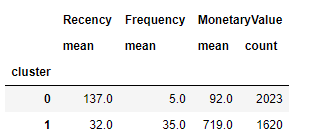Practical implementation of k-means clustering
Customer Segmentation in Python

Karolis Urbonas
Head of Data Science, Amazon
Key steps
- Data pre-processing
- Choosing a number of clusters
- Running k-means clustering on pre-processed data
- Analyzing average RFM values of each cluster
Data pre-processing
We've completed the pre-processing steps and have these two objects:
datamart_rfmdatamart_normalized
import numpy as np
datamart_log = np.log(datamart_rfm)
from sklearn.preprocessing import StandardScaler
scaler = StandardScaler()
scaler.fit(datamart_log)
datamart_normalized = scaler.transform(datamart_log)
Methods to define the number of clusters
- Visual methods - elbow criterion
- Mathematical methods - silhouette coefficient
- Experimentation and interpretation
Running k-means
# Import package
from sklearn.cluster import KMeans
kmeans = KMeans(n_clusters=2, random_state=1)
# Compute k-means clustering on pre-processed data
kmeans.fit(datamart_normalized)
# Extract cluster labels from labels_ attribute
cluster_labels = kmeans.labels_
Analyzing average RFM values of each cluster
# Create a cluster label column in the original DataFrame
datamart_rfm_k2 = datamart_rfm.assign(Cluster = cluster_labels)
# Calculate average RFM values and size for each cluster
datamart_rfm_k2.groupby(['Cluster']).agg({
'Recency': 'mean',
'Frequency': 'mean',
'MonetaryValue': ['mean', 'count'],
}).round(0)
Analyzing average RFM values of each cluster
The result of a simple 2-cluster solution:
Let's practice running k-means clustering!
Customer Segmentation in Python


